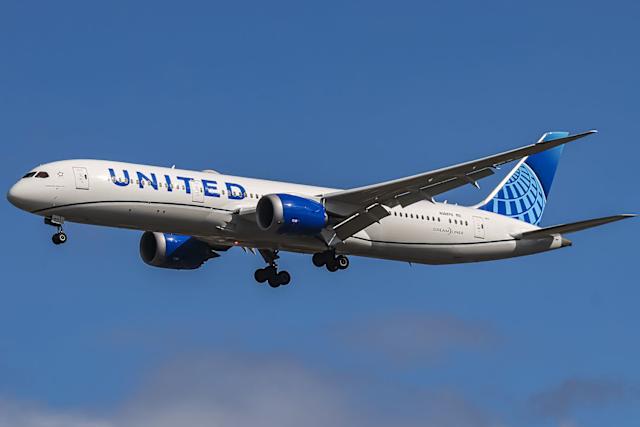
On a routine flight that was supposed to be uneventful, terror struck thousands of feet above the earth when a United Airlines jet suddenly plummeted 25,000 feet in just eight minutes. The sharp and frightening descent left passengers gripped with fear, oxygen masks dangling from the ceiling, and one unfortunate traveler bloodied in the aisle.
What was meant to be a smooth journey became an unforgettable nightmare for those on board, a chilling reminder of how quickly circumstances can change at cruising altitude.
—
The Terrifying Descent
According to eyewitnesses, the flight began normally, with passengers settling in, attendants serving drinks, and the hum of the engines providing the usual background noise. But about halfway through the journey, the aircraft experienced a sudden drop in cabin pressure. Almost instantly, alarms blared and oxygen masks deployed, signaling that something had gone terribly wrong.
The plane, which had been flying steadily at over 30,000 feet, started losing altitude at a rapid rate. Within minutes, it had plunged 25,000 feet. What passengers felt was not just a physical drop, but a psychological freefall into chaos and panic.
Some passengers screamed, others prayed, and many gripped their armrests with white knuckles. “It felt like the bottom dropped out of the sky,” said one shaken traveler.
—
Chaos in the Cabin
As the jet descended, turbulence added to the horror. Drinks spilled, luggage shifted, and oxygen masks dangled in front of terrified faces. In the middle of this, a passenger reportedly lost balance, hitting the side of the aisle and sustaining a bleeding injury. Witnesses described the sight of the injured traveler as the most horrifying part of the ordeal, a stark visual of the flight’s mayhem.
Flight attendants, trained for emergencies, rushed to maintain order. They guided passengers on how to use oxygen masks and tended to the injured traveler as best as possible given the circumstances. Their calm under pressure likely prevented the situation from spiraling even further out of control.
—
Why Do Planes Plunge Like This?
Rapid descents are not common, but when they occur, they are usually the result of one of several critical issues:
1. Loss of cabin pressure – If the cabin loses pressurization, pilots are trained to descend quickly to a safe altitude where passengers can breathe without supplemental oxygen.
2. Mechanical failure – Engine or system issues may require pilots to bring the aircraft down quickly.
3. Turbulence or structural concerns – Severe turbulence or concerns about the plane’s integrity can also prompt rapid altitude changes.
While dramatic, controlled descents are often part of standard safety protocol. Pilots are trained to prioritize survival over comfort, which means losing altitude quickly to safeguard oxygen levels for everyone on board.
—
Passenger Accounts of Fear
Survivors of the flight described an overwhelming sense of vulnerability. One passenger recalled clutching their child’s hand, fearing they would never see home again. Another said the entire cabin was filled with gasps, prayers, and sobs.
“The plane just kept dropping. It was like a roller coaster that wouldn’t stop,” one shaken traveler told reporters.
For many, the most chilling moment was seeing a fellow passenger collapse, blood streaking across the aisle floor as others screamed for help.
—
Airline Response
United Airlines released a brief statement confirming the incident, noting that the pilots had followed safety protocols and managed to stabilize the aircraft after the rapid descent. The airline expressed concern for the injured passenger, promising to cover medical expenses and investigate the cause of the emergency.
“Safety is our top priority,” the airline said in its statement. “Our crew responded professionally and ensured that the flight landed safely.”
Despite their assurances, the incident is sure to reignite debates over aviation safety, equipment maintenance, and the mental toll on passengers who survive such terrifying ordeals.
—
The Psychological Toll
While physical injuries are the most visible aftermath of such an event, the psychological scars may linger much longer. Sudden near-death experiences, especially in enclosed environments like an airplane cabin, can trigger post-traumatic stress, anxiety about flying, or even long-term phobias.
Mental health experts note that survivors may replay the moments in their minds—oxygen masks falling, the loud alarms, the gut-wrenching drop, the screams of others. The image of a fellow passenger bloodied in the aisle could remain etched in memory for years to come.
—
Aviation Experts Weigh In
Aviation analysts stress that while terrifying, such incidents are statistically rare. Commercial jets are among the safest modes of transportation, with multiple backup systems designed to prevent disaster. Pilots undergo extensive training for emergency descents, ensuring they can stabilize the situation as quickly as possible.
Still, experts caution that every emergency highlights the importance of strict aircraft maintenance and crew readiness. The Federal Aviation Administration (FAA) will likely review this incident in detail to determine if mechanical failure, equipment malfunction, or human error played a role.
—
Lessons for Passengers
For travelers shaken by the headline, aviation safety experts offer a few takeaways:
Always pay attention to the safety briefing. Oxygen masks, seatbelts, and brace positions save lives in emergencies.
Keep seatbelts fastened whenever seated. Sudden drops or turbulence can cause serious injuries to unbuckled passengers.
Trust the crew. Flight attendants and pilots are extensively trained to handle chaos calmly and effectively.
Seek help after traumatic flights. Talking with professionals or support groups can ease lingering fear.